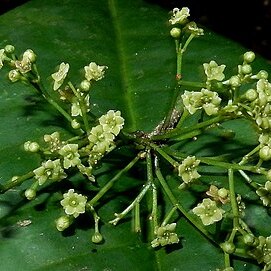Lianas or slender shrubs or trees with the upper branches scandent, glabrous throughout or essentially so; milky latex often present. Leaves opposite or sub-opposite, rarely alternate, petiolate, the petiole canaliculate. Inflorescences axillary or arising from defoliate branchlets, pedunculate or not, thyrsoid-paniculate or pseudodichotomously branching. Flowers hermaphrodite, small, sessile or short-pedicellate, arranged in loose clusters of 2-5 near or at the apex of ultimate branchlets; sepals 5, narrowly imbricate, broader than long, obtuse or rounded at the apex, entire to fimbriate at the margins; petals 5, narrowly imbricate, usually rounded at the apex, entire to erosulous at the margins, submembranous to thin-carnose; disc continuous, short-cylindric, free or sometimes adnate to the ovary by inconspicuous, interstaminal septa, entire or undulate or crenulate at the margin, membranous to thin-carnose; stamens 3, rarely 4, erect to subspreading, the fila-ments ligulate, the anthers usually extrorsely nutant, broader than long, the thecae usually subglobose and laterally confluent, dehiscing by transversal, confluent, extrorse clefts; ovary depressed-conical or 3-gonous, the angles usually rounded, 3-celled, each cell usually 2-ovulate, the ovules collateral or superposed; style short, terete, carnose, the stigmas 3, obvious and divaricate, alternate with or opposite to the stamens and the cells of the ovary, entire or 2-lobed, sometimes obscure. Fruits drupaceous, often large, the pericarp coriaceous or woody, the dissepiments persistent or evanescent; seeds usually few, embedded in mucilaginous pulp, angu-late, wingless.
More
Lianas, slender shrubs or small trees, essentially glabrous; branches opposite or subopposite, often swollen and slightly flattened at the nodes. Leaves often with intermediates between the secondary veins. Inflorescences axillary on leafy or defoliate branches, thyrsoid-paniculate or(pseudo-)dichotomously branched; flowers loosely clustered, 2-5 together at or near the end of ultimate branchlets, subtended by minute, caducous bracts. Sepals 5 (rarely 4 or 6), entire to fimbriate; petals 5 (rarely 4 or 6), usually rounded, often papillose distally; disk short tubular, margin entire, undulate or crenulate; stamens 3, erect to reflexed, filaments ligulate, sometimes broadened towards the base, anthers transversely ellipsoid or reniform, dehiscing by transverse, confluent clefts either apical or extrorsely, and then giving a butterfly-like appearance (not so in T. cylindrocarpa and T. nectandrifolia); ovary depressed-conical or subtrigonous, 3-locular, ovules 2-4 per locule (to 8 in T. cylindrocarpa), collateral or superposed, style short, subulate or truncate (then stigmas obsolete), stigmas 3, conspicuously divaricate, opposite to or alternating with the stamens, entire, emarginate, bilobed or bifid. Fruits usually subglobose, ellipsoid or cylindric, pericarp coriaceous to woody; seeds usually few, angled, embedded in mucilaginous pulp.

